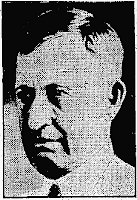 |
| Merl Williams |
A midwife, 57-year-old. Cordelia Moore, was charged with abortion murder. An investigation found evidence that Moore, formerly a registered nurse, had perpetrated hundreds of abortions in her home in Longdale, Oklahoma.
After her arrest, Moore "unworriedly set her glasses on the end of her nose and continued her quilting in the county jail." Her husband, John, actually got up in his cell and jigged when a jaunty tune came on the radio.
W. C. Mouse, a railroad engineer, testified that he had taken Merl to Moore's 3-room farm house on April 11, not knowing the reason for the visit. He said only that he had heard Merl ask Moore, "Will it be dangerous?" The state also gathered 14 additional witnesses in the case against Moore, including women swearing under oath that Moore had done abortions on them. The prosecutors were also investigating the possible abortion death of a married woman a few years previously.
Cordelia Moore was tried for the crime; her husband, John, was arrested but released. I have been unable to determine that outcome of any trial in Merl's death.
Oklahoma City, 1932: Two Docs' Deadly Spree
 |
| Dr. J. W. Eisiminger |
Virginia was transferred from Mrs. Prices's home to Oklahoma City General Hospital, where she died of septicemia, first having told doctors there that Eisiminger had performed the fatal abortion.. A deathbed statement absolving Eisiminger was proven to be a forgery.
Eisiminger was sentenced to life in prison after pleading guilty to murder in her abortion death. The sentence was later reduced to 15 years.
 |
| Dr. Richard Thacker |
Mrs. Roach had come to Thacker's office several times, he admitted. Thacker said that she had been in poor health and emaciated, and had a white discharge, indicative of infection, from her vagina. She also, Thacker said, had pains in her abdomen. Thacker said that he treated her with a tonic and with antiseptic tampons.
He adamantly denied that he had performed an abortion on her. However, other witnesses, including Mrs. Roach's husband, testified that Thacker had indeed performed an abortion on Mrs. Roach, causing her death. Thacker was only prosecuted for Ruth Hall's death and was sentenced to life in prison. This is probably why he wasn't prosecuted for any of the other deaths. He died in prison in 1937.
Chicago, 1920: An Unidentified Perpetrator
On April 24, 1920, Emma Shanahan died at Chicago's St. Anthony Hospital from an abortion perpetrated by a person who was not identified. Most abortionists in Chicago in that era were doctors or midwives, which makes it likely that Emma availed herself of one of these trained medical professionals.
Hannibal, Illinois, 1893: Racist Coverage of an Abortion Death
An article on the death of 19-year-old Emma Hub underscores the racism of the time. It begins, "Uncle Billy Nickens, a well-known colored character of Hannibal [Illinois], was arrested there yesterday charged with causing the death of Emmy Hub by a criminal operation."
Emma was the daughter of Jacob Hub, a German shoemaker living just south of the Hannibal city limits. Jacob had expelled his daughter from the house due to "her wild habits", so she had moved in with a painter named Mathew Seoville. Around April 15 of 1893, Emma took ill, and was tended by a Dr. Ebbits. Ebbits suspected an abortion and refused to treat Emma until she admitted to it. "She continued to grow worse until death relieved her suffering at 1 a.m. yesterday" -- that being April 24.
Emma had told Mathew Seoville and his wife that she had gone to Nickens' house, where he had used instruments on her to cause an abortion. She said that a girl from Illinois was also there for an abortion. Mathew had pressed Emma to write up a declaration.
The fatal abortion was reportedly Emma's second; the previous had been performed the previous October. She also had given birth to a child about two years earlier. The article notes that Nickens was arrested, adding, "The negro has been brought up on similar charges before, but always managed to clear himself."
No comments:
Post a Comment